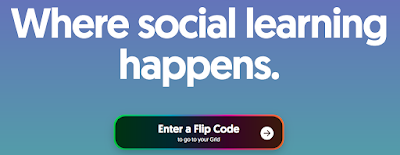No problem.
I can talk about genres in fun ways, mingling in book talks and making the genres all sound super cool.
But still.
It's just listening on the students' part. For a review lesson, wouldn't it be more engaging if the students did the talking instead of me? Of course! And I'd get some good diagnostic information as well.
Enter Flipgrid.
I've played around with it before but this was my first time using it with students.
I set up three stations.
 At each one:
At each one:- a stack of books for each genre (Realistic Fiction, Historical Fiction, Adventure)
- a pen and note-taking sheet
- a Chromebook set up to a Flipgrid video task
Directions:
1) Become familiar with the genre. Review the books on the table, brainstorm and take notes on the elements of the genre, and share favorite titles in that genre.
2) Plan and create a video advertisement for that genre. All group members must be in the video. The video must "sell" that genre as "the best." Video cuts off after 3 minutes. The elements of the genre must be clearly featured.
 It sounded like a pretty tight plan to me, but in my vision, the group stayed at their table, quietly talking into the laptop to film.
It sounded like a pretty tight plan to me, but in my vision, the group stayed at their table, quietly talking into the laptop to film. Exploding into other parts of the library to build a mountain out of the beanbags wasn't what I pictured.
What happened?
The minute students found out they would create a video, they started spinning out all kinds of wild and creative ideas. The adventure group wanted to create their ad in the style of an adventure - plane crash survival! The realistic fiction group wanted to sob their way through a sad story.
It became crazy very quickly! Also: seeing themselves on camera induced fits of giggles!
Happily, the teacher is a laid-back guy and we tamped down the volume as needed. I thought the results were going to be way off-topic based on the amount of action compared to information there seemed to be.
However, when I viewed the videos later, I was, for the most part, surprised to see that the kids pulled it off! Maybe I'd like to hear a bit more about the elements of the genre next time, but overall they got the gist. And the enthusiasm! It was great.
At first I planned to limit the next groups to staying in their seats for filming, but after seeing the creative responses to the task, I decided to let them continue to branch out. I did assign them filming areas further apart to help noise control. And I gave them more concrete time limits: 10 minutes for notes, 5 minutes to plan, 5 minutes to film.
 Another thing: Before uploading the video, the kids take a "selfie" which becomes the-most-important-thing-ever. A friendly reminder to keep track of their time at this stage helps.
Another thing: Before uploading the video, the kids take a "selfie" which becomes the-most-important-thing-ever. A friendly reminder to keep track of their time at this stage helps.Flipgrid for the win - I just need to be ready to manage some of the silliness! It might bring out the crazy but it's worth it for the high level of engagement.

PS: Flipgrid is FREE for educators.
You create a Grid and then add Activities (like tasks) within the Grid. Students will need to input their school email (with school domain) in order to access.
A work-around for this: have the computers open to Flipgrid and already logged into your own account. The videos will publish as if they are from you, but the kids take a selfie before posting, so they will be able to see which ones are theirs. This skips the whole logging in and inputting a code.
Anyone else have tips on how to manage the silly factor or logistics of Flipgrid?

No comments:
Post a Comment